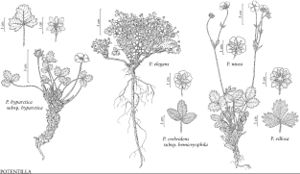Potentilla villosa
Fl. Amer. Sept. 1: 353. 1813.
Plants ± to densely tufted. Caudex branches stout, sometimes short-columnar, not sheathed with marcescent whole leaves. Stems ascending, 0.5–2 (–2.5) dm, lengths 1.5–3 times basal leaves. Basal leaves 2–12 (–15) cm; petiole 1–9 (–12) cm, long hairs ± abundant to dense, spreading to ascending, 1–2.5 (–3) mm, soft to weak, smooth, crisped hairs absent or sparse, cottony hairs absent, glands sparse to common, sometimes obscured; leaflets usually ± overlapping, central broadly obovate to suborbiculate, (0.5–) 1.5–2.5 (–3) × (0.5–) 1.5–2.6 (–3.2) cm, sessile to subsessile, base cuneate to rounded, margins revolute, distal 1/2–2/3 (–3/4) incised 1/4–1/2 to midvein, teeth 3–6 (–7) per side, ± approximate to ± distant, surfaces ± dissimilar, abaxial yellowish or grayish white, long hairs 1–2 mm, cottony-crisped hairs ± dense, adaxial grayish green, long hairs abundant to dense, crisped hairs absent, sparse, or obscured. Cauline leaves (0–) 1–2. Inflorescences (1–) 2–7 (–10) -flowered. Pedicels 0.5–3 (–4) cm in flower, to 4 cm in fruit. Flowers: epicalyx bractlets ovate to oval-elliptic, 3–8 × 2–5 mm, 2/3 to as wide as sepals, margins strongly revolute, red-glands absent; hypanthium 5–7 mm diam.; sepals 4–8 mm, apex ± acute; petals (5–) 7–15 × 7–16 mm, significantly longer than sepals; filaments 1.8–2.1 mm, anthers 0.7–0.8 mm; carpels 150–250, apical hairs usually absent, rarely present (cottony), styles narrowly conic to tapered, ± papillate-swollen on proximal 1/5–1/2, 0.9–1.1 mm. Achenes 0.9–1.3 mm. 2n = 14.
Phenology: Flowering spring–summer.
Habitat: Sea cliffs, gravel beaches, inland on alpine outcrops (primarily southern populations), pumice barrens, scree and rock ledges
Elevation: 0–100(–1800) m
Distribution

B.C., Alaska, Oreg., Wash., e Asia (Russian Far East)
Discussion
Potentilla villosa is the only documented diploid species of sect. Niveae in North America and, almost certainly, it is fully sexual. It is a characteristic species of coarse-grained beaches and coastal cliffs from southwestern British Columbia to western Alaska and the Russian Far East, and also occurs on scattered mountains in the Olympic Peninsula and Cascade Range of Washington and Oregon (providing the higher elevational extreme). These southern populations, which have been called var. parviflora, tend to be smaller, more delicate, less hairy plants in general, with fewer and smaller flowers. At least some plants in some southern populations also have cottony hairs on the carpels.
Selected References
None.
Lower Taxa
"thin" is not a number."dm" is not declared as a valid unit of measurement for this property."-3timesbasalleaves" is not declared as a valid unit of measurement for this property."dm" is not declared as a valid unit of measurement for this property."dm" is not declared as a valid unit of measurement for this property.
